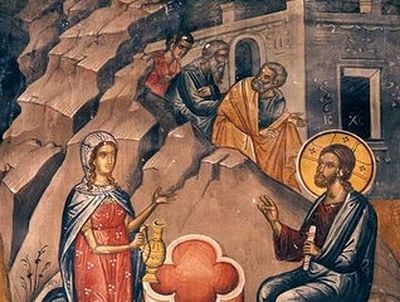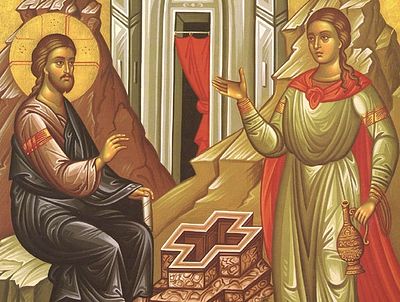Christ is Risen!
For three weeks from the day of the Bright Resurrection of Christ, the Holy Church is unable to tear itself away from events directly connected with the Resurrection of the Lord Jesus Christ.
The first week passes in the joyous exaltation of the Resurrection itself, the second in recollection of how the holy apostle Thomas came to believe, and the third in how the righteous Joseph and Nikodemos served Christ the Savior and how the Myrrhbearing Women went to the Tomb of the Resurrected Christ, seeing first an angel and then the Risen Lord Himself.
The feast of Pascha continues, but in the following weeks, other events that occurred before the Crucifixion and Resurrection of Christ are remembered in our Church services along with the glorification of the Resurrection of Christ. These are the miraculous healing of the paralytic and the man born blind, and as on this present Sunday, the turning of the Samaritan Woman to faith in the Lord Jesus as Savior.
What is the connection between the Resurrection of Christ and these events?
Both in the Resurrection and in these events, it is the power of God that acts.
And there is another, special connection between them, which we will examine closer.
We typically refer to the Resurrection of Christ as the feast of Pascha. And what does the word “pascha” mean? This word means “crossing over.” Christ is risen and has translated us from death to life, and from Earth to Heaven. Thus we sing in the first Irmos of the Paschal Canon: “For from death to life, and from earth to heaven hath Christ God brought us…”
Pascha means a passing over in many ways: from death to life, from destruction to salvation, and also in an earthly sense—from disease to health. The last is seen in the examples of the paralytic and the man born blind.
The first man lay, unable to stand up, for thirty-eight years, but, by the word of Christ, he arose, walked, and carried his bed (Jn. 5:1-15).
The other was unable to see his entire life from birth, but obeyed Jesus Christ as the Son of God (Jn. 9:1-38).
Let us consider now the example of the Samaritan Woman.
A crossing over from the worse to the better occurs several times with her.
First the physical crossing: She goes for water outside the town, leaves it and comes to a well. It is a holy place. This ancient well was already around 2,000 years old when the Gospel event happened, having been dug by Abraham’s grandson Jacob for his son Joseph (Jn. 4:5-6). The Samaritan Woman probably went to this well every day. Such a walk after water detaches a person from life’s commotion, from daily labors, and disposes him to receive Divine wisdom. And one day, when she met our Lord Jesus Christ at the well, she was spiritually reborn, making a great transition from spiritual darkness to the light of faith.
Christ says to her, If thou knewest the gift of God, and who it is that saith to thee, Give me to drink; thou wouldest have asked of him, and he would have given thee living water (Jn. 4:10), and then, But whosoever drinketh of the water that I shall give him shall never thirst; but the water that I shall give him shall be in him a well of water springing up into everlasting life (Jn. 4:14).
The Samaritan Woman received the living water of Christ: She came to believe in the Lord Jesus Christ as Savior. She herself became a fountain of living water, according to the word of Christ, because she preached the Lord to her fellow citizens, and they came to Christ and believed in Him (Jn. 4:29-30, 39-42).
Within this, the main transition in the life of the Samaritan Woman, we can see two others.
The first is the moral change and purification of her personal life. When the Samaritan Woman asked Christ, Sir, give me this [living] water, the Savior answered her, Go, call thy husband, and come hither; but the Samaritan Woman replied, I have no husband. As is clear from what happens subsequently, the Samaritan Woman was dodging. She wanted to hide the shortcomings of her personal life from the Savior.
Instead of chiding her, the Savior praised her with the art of a great Teacher and Doctor, saying, Thou hast well said, I have no husband: For thou hast had five husbands; and he whom thou now hast is not thy husband: in that saidst thou truly.
And then, understanding that her life was open before the Lord, she agreed with Him and said, Sir, I perceive that Thou art a prophet (Jn. 4:15-19).
There is no doubt: Her agreement with the Lord cleanses and changes her soul. The Samaritan Woman, pronouncing the words of agreement, becomes a new person, and is cleansed. Spiritual interest is awakened in her. In its appearance consists another crossing over from the worse to the better. As a result, the Samaritan Woman immediately asks the Lord an important religious question, which probably occupied not just her, but also her countrymen. Having said, Sir, I perceive that Thou art a prophet, she continues, Our fathers worshipped in this mountain; and ye say, that in Jerusalem is the place where men ought to worship (Jn. 4:19-20). Christ the Savior explains to the Samaritan Woman that God can be worshiped anywhere, and at the same time calls God “Father.” He says, But the hour cometh, and now is, when the true worshippers shall worship the Father in spirit and in truth: for the Father seeketh such to worship him. God is a Spirit: and they that worship him must worship him in spirit and in truth (Jn. 4:23-24).
We can see in these words of the Savior an oblique reference to the mystery of the All-Holy Trinity. Worship the Father, that is, the first Person of the Holy Trinity, in the Spirit, that is, the third Person of the Holy Trinity, and Truth, that is, in the second Person of the Holy Trinity. Recall that Christ said about Himself, I am the Truth (Jn. 14:6).
Thus, to worship the Father in Spirit and in Truth means to enter into communion with the entire Holy Trinity. What a joy it is to worship God!
Again, the Samaritan Woman experienced so many saving crossovers from worse to better: a pedestrian crossing when she walked from home to the well, a transition from reproach to request that Christ give her the living water, a shift from superstition—that God could only be worshiped on a specific mountain—to the true faith in the Heavenly Father, Who is to be worshiped in Spirit and in Truth, and a crossing over from an unenlightened condition to faith in Christ as Savior.
Therefore, the event remembered today, the conversation with the Samaritan Woman, is a recollection appropriate for Paschaltide, when we celebrate our crossing over from death to life, and from Earth to Heaven, celebrating the Resurrection of Christ, to Whom be the glory!
Amen.






